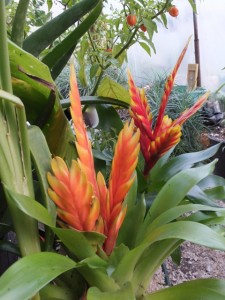Amongst very showy greenhouse specimens difficult to name out of flower yet most obvious in bloom are Flaming Sword, Lobster Claws and Painted Feather. These names accurately describe the fantastical red and yellow waxy flower spikes of massed bracts. Blooms once seen never forgotten, almost surreal, and so resembling plastic that people feel it necessary to touch them.
Those named here are Vriesia / Vriesea splendens, V. carinata and the hybrid V. x mariae but there’s a host of other rarer and some most spectacular species, hybrids and related genus. Indeed enough to fill even a palatial greenhouse, and with a wide range of leaf colour, size and variegation.
 Vriesias are Bromeliads like pineapples with the typical epiphyte rosettes of leaves. Bigger or smaller, wider, narrower, rolled or flattened, but basically sword shaped leaves often beautifully marked.
Vriesias are Bromeliads like pineapples with the typical epiphyte rosettes of leaves. Bigger or smaller, wider, narrower, rolled or flattened, but basically sword shaped leaves often beautifully marked.
Vriesia species vary but little in broad flower colour most have yellow flowers and red bracts. But the shades vary and are intense. Vriesia is a large genus of more than forty species and there are many more delightful variations with the closely related Guzmanias and Neoregelias, so many dozens more. Some so similar it’s hard to tell the difference out of bloom.
Indeed I once had the robust leaves of a healthy specimen of the variegated V. splendens out of bloom mistaken for a Mother-in-laws tongue, Sansevieria (to be fair the rosette base was hidden from view by some rambling vines).
The more easily findable Vriesia species and hybrids are not difficult to look after, if you remember they come from the rain forests of South America. Warm, humid dappled shade suits them, cold does not. Their ancestors lodged in leaf-mould pockets in branches or the jungle floor so they may scorch in hot bright conditions and naturally must only be given rain-water, preferably tepid warm.
(Some insist the central cup of these Bromeliads needs keeping full, at least during the warmer brighter months. However in difficult conditions, cooler and darker, it’s safer to keep the plants on the dry side to avoid mould, I even use a turkey baster to suck out any accidental build up.)
You can grow Vriesias from seed, it’s a bit slow though as some take seven or more years to bloom. So it’s much quicker to start with a commercially grown specimen, you can see what you are getting and that display will last for months more. And for most species the plant can then be kept for many years with only small increases in pot size. They are not demanding to size but re-potting must be with a fibrous leaf-mould or mossy peat-like compost not very rich in nutrients. Feed only lightly, and water or mist more often in dry atmospheres as when these are used as houseplants.


